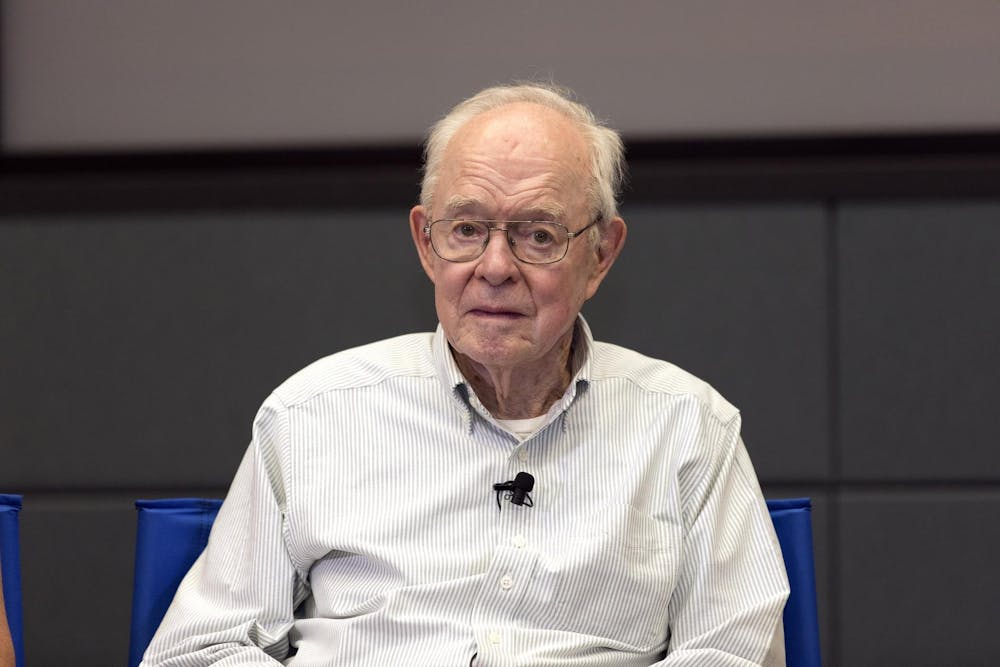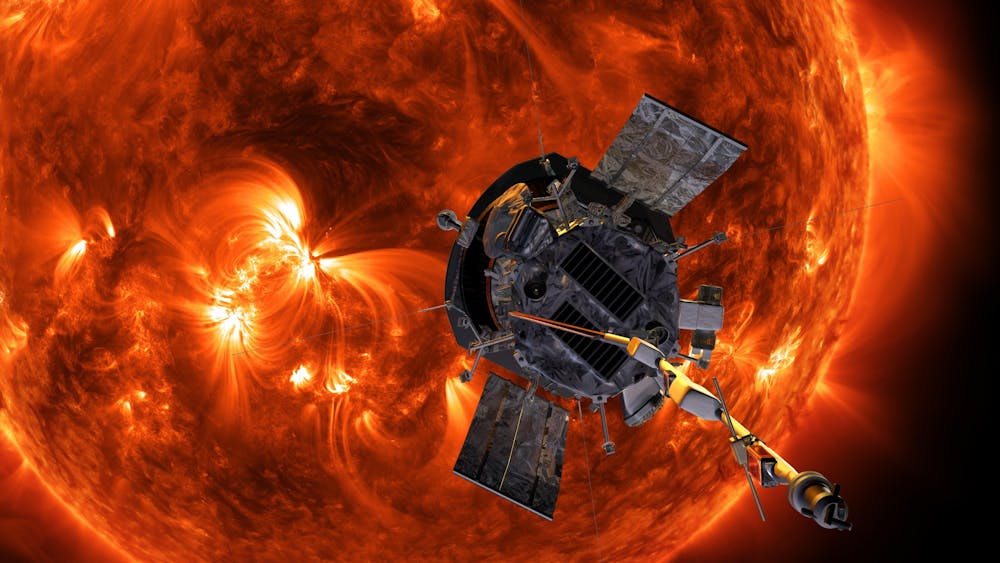The University Space Physics group and David J. McComas, a professor in the astrophysical sciences department, contributed to building a record-breaking spacecraft, which is providing new, crucial information about the solar winds and particles from the Sun’s outer atmosphere.
Launched atop a Delta IV Heavy rocket from Cape Canaveral Air Force Station in Florida on Aug. 12, 2018, the NASA Parker Solar Probe mission, nicknamed “Parker,” was a $1.5 billion project. The mission seeks to “touch the Sun,” discovering the secrets of the star’s corona by performing unprecedented observations and measurements of solar winds, magnetic fields, and energetic particles that originate from the star’s mysterious outer atmosphere.
Known as an enormous ball of extremely hot hydrogen and helium, the Sun has often been assumed to be hotter at its center than its outer layers. In reality, the Sun’s outer atmosphere, the corona, can be nearly 300 times hotter than its surface, or photosphere.
The NASA Parker Solar Probe mission will aid scientists in measuring, observing, and imaging the corona.
Set to be completed by 2025, Parker will perform seven Venus fly-bys, using the planet’s gravitational pull to complete 24 orbits around the Sun.
During its closest flyby, Parker will travel at a speed of 430,000 miles per hour at times coming as close as 3.8 million miles. These numbers represent the record for the fastest-traveling vehicle ever constructed by humanity and the closest distance to the Sun ever reached by a spacecraft.
David McComas, who also serves as the University Vice President for the Princeton Plasma Physics Laboratory, described the “three basic mysteries” of solar physics that Parker is set to investigate. McComas is the principal investigator for one of the instrument suites installed on the spacecraft.
“The same physical processes that occur at the Sun should surely be occurring at other stars, and so by understanding the details of those physical processes at our sun, we’ll understand how they work at other stars and across the galaxy,” explained McComas. “The first is ‘Why is the corona so hot?’ The second, ‘What accelerates the solar winds?’ And the third, ‘What produces and accelerates the solar energetic particles?’”

McComas delivered a guest lecture on the Parker mission for the Amateur Astronomers Association of Princeton at 7:30 p.m. on Feb. 11 in Peyton Hall.

Artist rendering of the Parker Solar Probe leaving Earth.
Photo Credit: Steve Gribben / NASA, Johns Hopkins APL
Parker’s mission of investigating the corona will be carried out by four separate instrument suites, each of which is responsible for directly studying coronal phenomena or imaging solar winds. During the first two flybys of Parker, the instrument suites produced observations that are described in a collection of four papers published in the scientific journal Nature.

The first instrument suite, Integrated Science Investigation of the Sun, or ISʘIS, is a University-led project under principal investigator McComas, mostly built at the Johns Hopkins Applied Physics Laboratory and the California Institute of Technology. ISʘIS measures electrons, protons, and ions across a broad spectrum of energies to better understand the origins of these particles and how they are accelerated from the Sun.
Colin J. Joyce, Postdoctoral Research Associate for the astrophysical sciences department at the University who conducts research as part of the ISʘIS team, spoke about some of the limitations of observing solar physics from Earth that can be overcome with the Parker mission.
“A lot of the solar storms that we have been able to observe with ISʘIS are very small and close to the Sun. They are small enough that we would not be able to detect them on Earth,” said Joyce. “One of the big questions that we have is why some events are bigger than others. The exciting thing about measuring these small events is that they can really play a big role of creating a population of particles that feed these larger events.”
The second instrument suite, known as FIELDS, is constructed and operated through a scientific collaboration led by the Space Sciences Laboratory at the University of California at Berkeley and principal investigator Professor Stuart B. Bale. It is responsible for taking direct measurements of the electric and magnetic fields among the solar winds of the corona. FIELDS detected unexpectedly frequent and large-scale reversals in the directions of the magnetic fields, the cause of which remain unexplained.
The third instrument suite, the Wide-Field Imager for Parker Solar Probe, or WISPR, is the only instrument suite on Parker used for imaging and not measuring the corona. Led by principal investigator Dr. Russell Howard and developed by the Solar and Heliophysics Physics Branch at the Naval Research Laboratory in Washington, D.C., WISPR takes images of the corona and the inner heliosphere, as well as the solar winds and other solar structures, such as coronal mass ejections (CMEs), that pass Parker and are measured by the other instruments.
The fourth and final suite, Solar Wind Electrons Alphas and Protons Investigation, or SWEAP, is led by principal investigator Professor Justin Kasper of the University of Michigan and chiefly built and jointly operated by the Space Sciences Laboratory in Berkeley and the Smithsonian Astrophysical Observatory in Cambridge, Mass. It counts the most abundant particles present in coronal solar winds — electrons, protons and helium ions — and measure properties such as their velocities, densities, and temperatures.
The Parker mission has the potential to greatly improve scientists’ understanding of solar phenomena and ability to predict space weather, helping them to foresee incoming solar energetic particles that can often be dangerous to astronauts and disruptive to electronics.
In an email to The Daily Princetonian, Adam Szabo, the Parker Mission Scientist and Chief of the Heliospheric Physics Laboratory at the NASA Goddard Space Flight Center, looks forward to whatever follows the conclusion of the current Parker mission.
“Besides understanding [solar energetic particles] better, Parker will give us our first look of the solar wind below what is called the Alfvén radius,” wrote Szabo. “This new look should give us a new understanding of how the solar wind gets accelerated to supersonic speeds, answer why the solar corona is so much hotter than the photosphere, and from which solar structures the slower solar wind comes from.”
Parker is named after Eugene Newman Parker, an astrophysicist and the S. Chandrasekhar Distinguished Service Professor in Physics, Emeritus, at the University of Chicago, who predicted the existence of solar winds in 1958. The Parker Solar Probe is the first NASA mission to be named after a living individual.

The University of Chicago astrophysicist Eugene Newman Parker, after whom the Parker Solar Probe is named.
Photo Credit: NASA
Now at the age of 92, Parker is thrilled to see the observation of phenomena predicted by his theories over half a century ago.
“It was humbling to see the probe’s launch and watch it disappear into the night sky,” said Parker in a statement provided by the University of Chicago. “But now that data is finally coming in and being analyzed, things are getting really exciting.”
More missions to study the Sun are already underway: the NASA/ESA Solar Orbiter, launched on Feb. 9, will travel to Mercury’s orbit with 10 instruments and complement Parker by making solar disk remote imaging. The NASA Polarimeter to Unify the Corona and Heliosphere (PUNCH) mission, set to be launched in 2022, plans to take exceptionally high spatial resolution coronal images of the solar wind.








